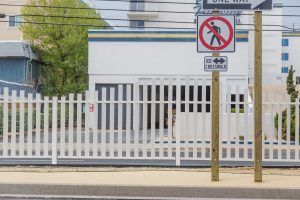
OCEAN CITY — With the first summer season with the new median fence down a vast section of Coastal Highway in the midtown area now in the books, local officials believe the project has accomplished its early goals.
The much-debated median fence project with enhanced lighting got underway last fall. The median fence is expected to improve public safety in the known trouble spot section of Coastal Highway, which historically has seen the most pedestrian-vehicle collisions, by forcing pedestrians to cross the highway at marked crosswalks at street ends and not dash across between blocks.
The project, which was designed by the State Highway Administration (SHA) with significant input from Ocean City officials, cost $4.5 million for the initial phase. The project features an undulating fence down the center median of Coastal Highway mimicking the iconic fences along the dunes in Ocean City complete with the appropriate landscaping to complete the illusion. No less important is the improved lighting along the corridor with higher wattage LED lights on poles in the center median.
While the aesthetic value of the new median fence continues to be debated, at least statistically it appears to have accomplished its goals in the first summer season. Pedestrian collisions in the known trouble spots where the fence was installed were down slightly from last year, according to Ocean City Police Department (OCPD) Public Information Officer Lindsay Richard.
“We at the police department feel that the median fence has been a success,” she said. “Even if just one pedestrian collision is prevented because of the fence, it is a success.”
Richard said while there were still a handful of pedestrian collisions reported in the median fence area, none were attributed to mid-block crossings.
“We have seen a decrease in the area of the fence and have seen virtually no pedestrian collisions at mid-block thanks to the fence,” she said. “The goal of the fence was to deter pedestrians from crossing Coastal Highway outside of an intersection and that goal has most definitely been achieved.”
The statistics appear to bear that out at least to some degree. For example, there were five reported pedestrian-vehicle collisions in the area of the new median fence from 40th Street to 62nd Street thus far since the fence was completed prior to Memorial Day, representing a decrease from the nine reported in all of 2017 in same area.
The statistics are somewhat subjective, however. For example, there were just two pedestrian collisions in that same area in 2016 and four the year before. There were eight pedestrian collisions in that area in 2014 and a high of 12 in 2013, so it’s a little hard to make any definitive assertions about the fence’s effectiveness without a larger sample size.
However, Richard pointed out the five reported pedestrian collisions in the area of the median fence this summer were minor in nature and did not involve mid-block crossings, the very activity the fence is designed to prevent.
“All five crashes that occurred from 40th Street to 62nd Street where the median fence is located involved either the pedestrian walking north or south and being hit in the entrance to a parking lot as a car was turning, or the pedestrian crossing at an intersection against the signal.”
Meanwhile, Public Works Director Hal Adkins, who worked closely with SHA through the design and installation process, said this week he thought the early indications are the fence did what it was designed to do. Adkins also said many of the naysayers who did not like the aesthetics of the median fence at first have started to come around.
“I think it has been successful,” he said. “I think it has aesthetically grown on a lot of people as it has filled in with the landscaping. We’ve actually started getting compliments from some of those who did not like it at first.”
Adkins said he had not seen any official statistics on pedestrian collisions in the fenced area, but anecdotally believed it was achieving the desired results.
“I’m not aware of any major pedestrian collisions in that area this summer,” he said. “On a rare occasion, I’ve seen somebody walking down the inside of the median fence as if they’ve walked out there not realizing they couldn’t cross. Beyond that, I think it has been a success.”
Another major component of the median enhancement project has been the installation of increased lighting down the center of Coastal Highway which casts a wide swath from sidewalk to sidewalk. No decision has yet been made on removing the existing cobra-head lights along the sidewalks, but Adkins said the new median lighting has been a success. He also said he hopes SHA will continue to move forward with future phases.
“I like the street lighting a lot and I think that achieves its goal,” he said. “I hope the State Highway Administration finds the funding to complete future phases from 9th Street all the way to the Delaware line over the next few years. That will certainly be a discussion in November when State Highway sits down with the Mayor and Council.”

